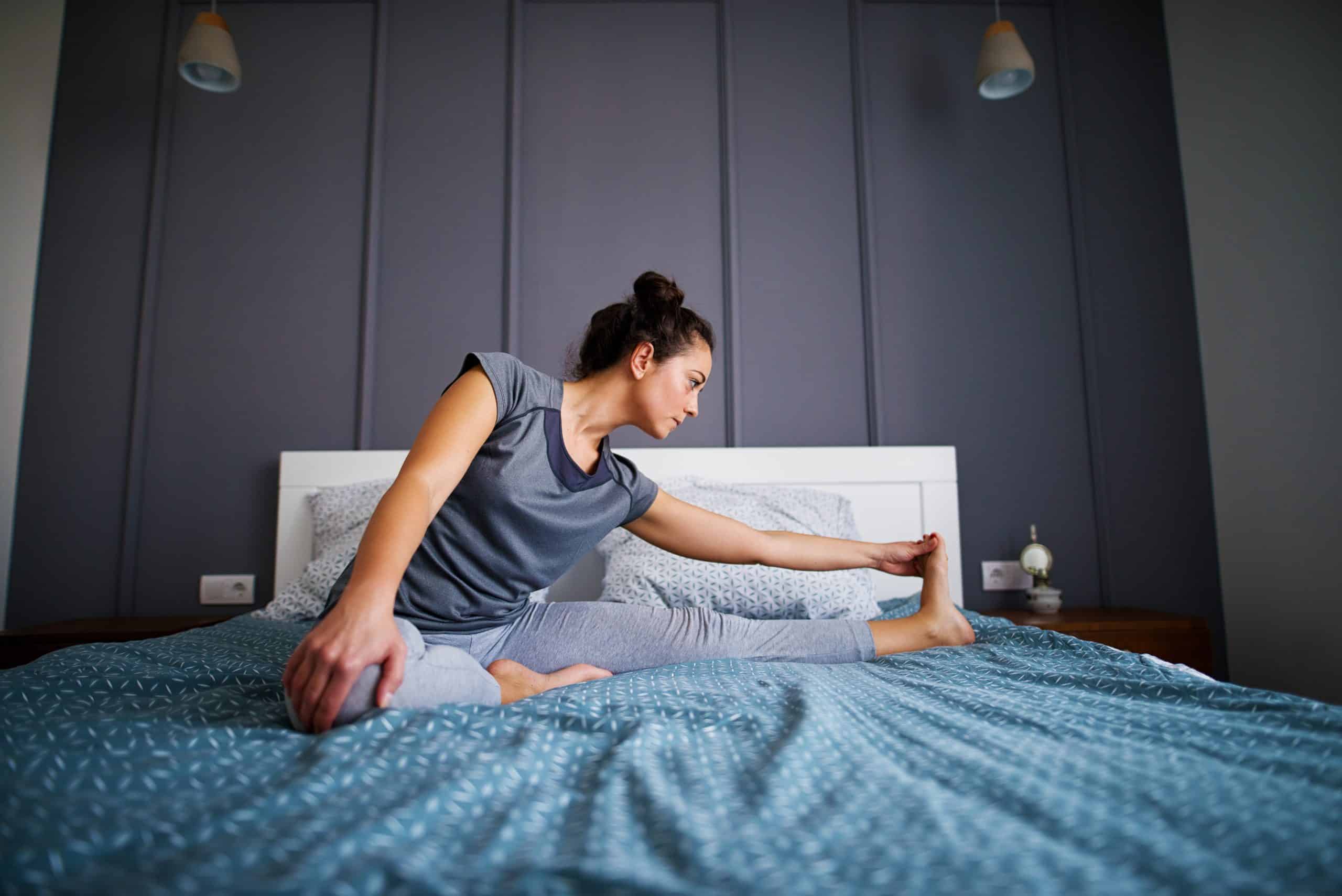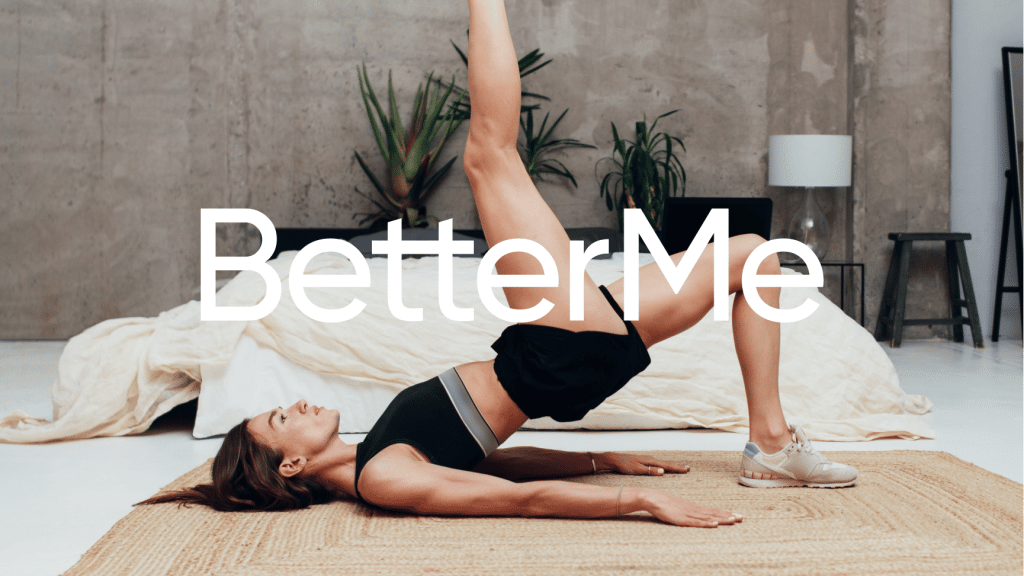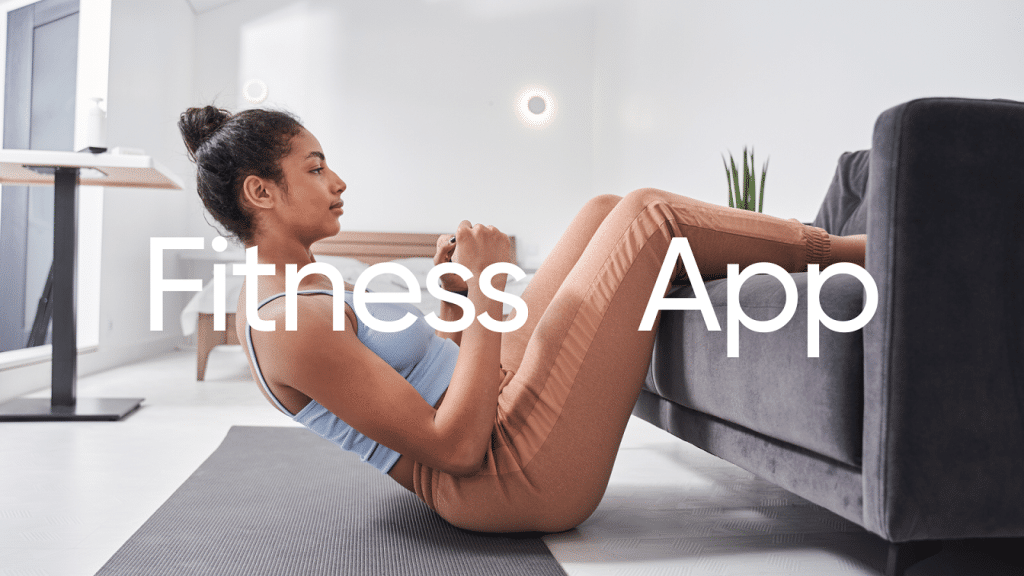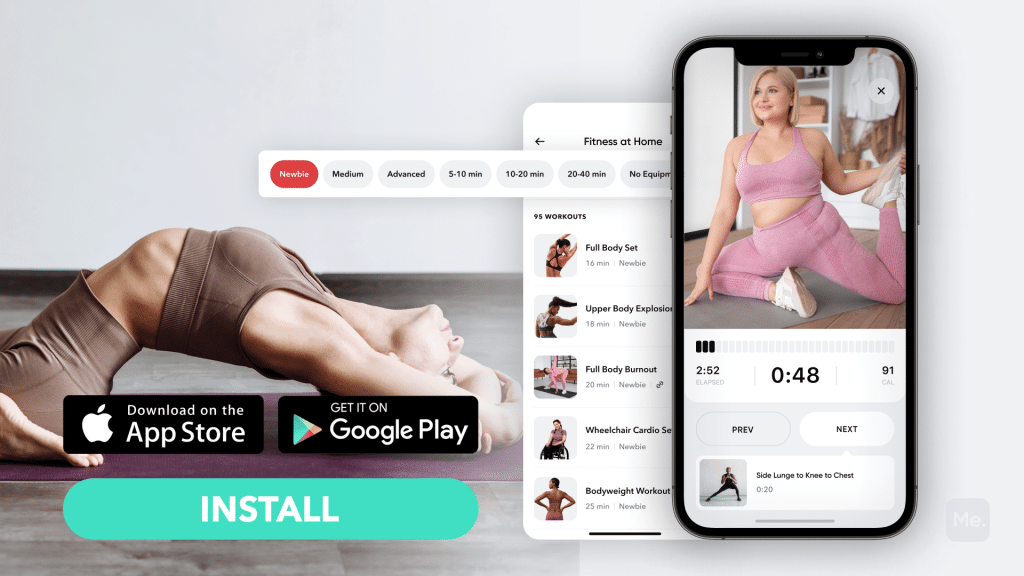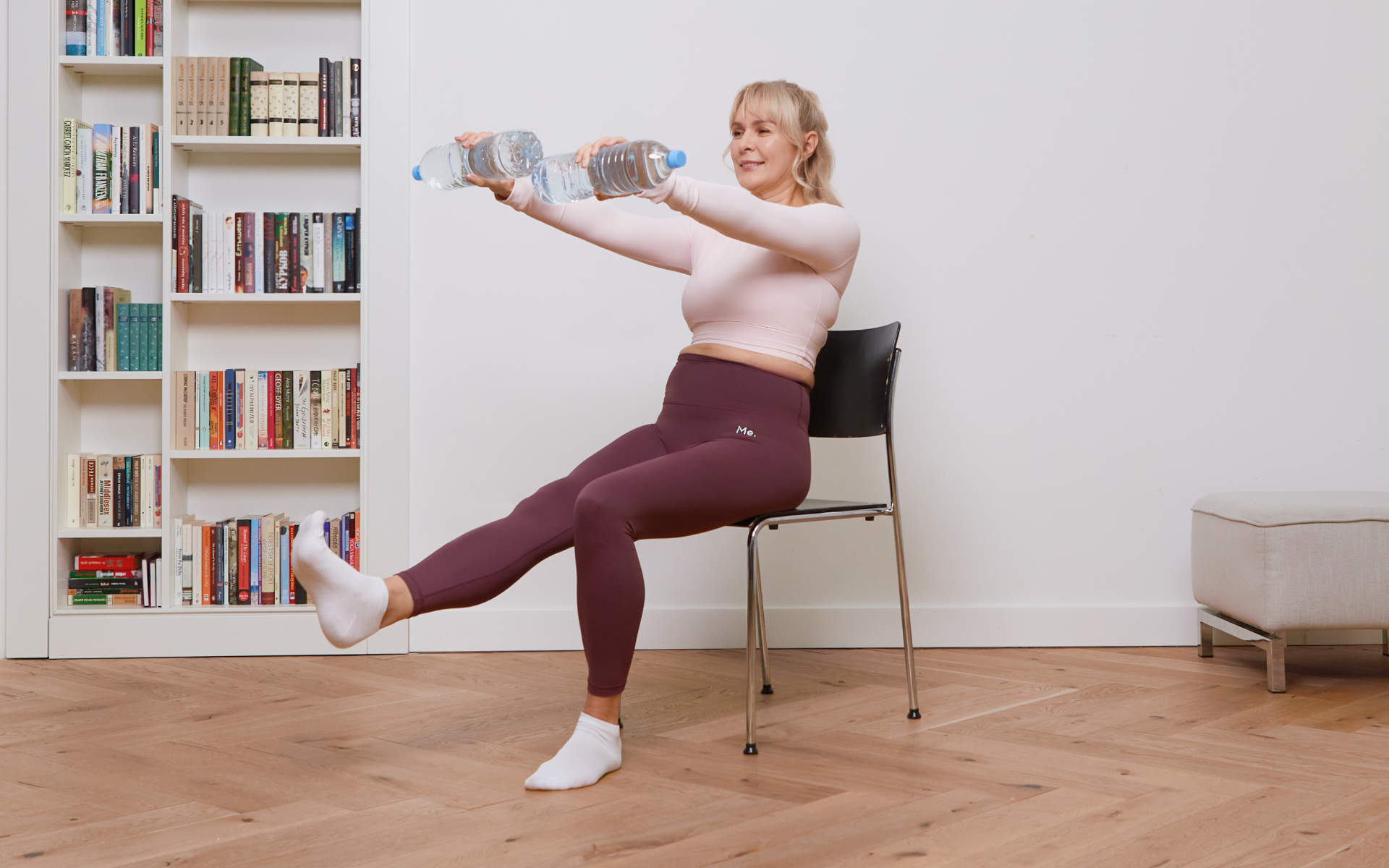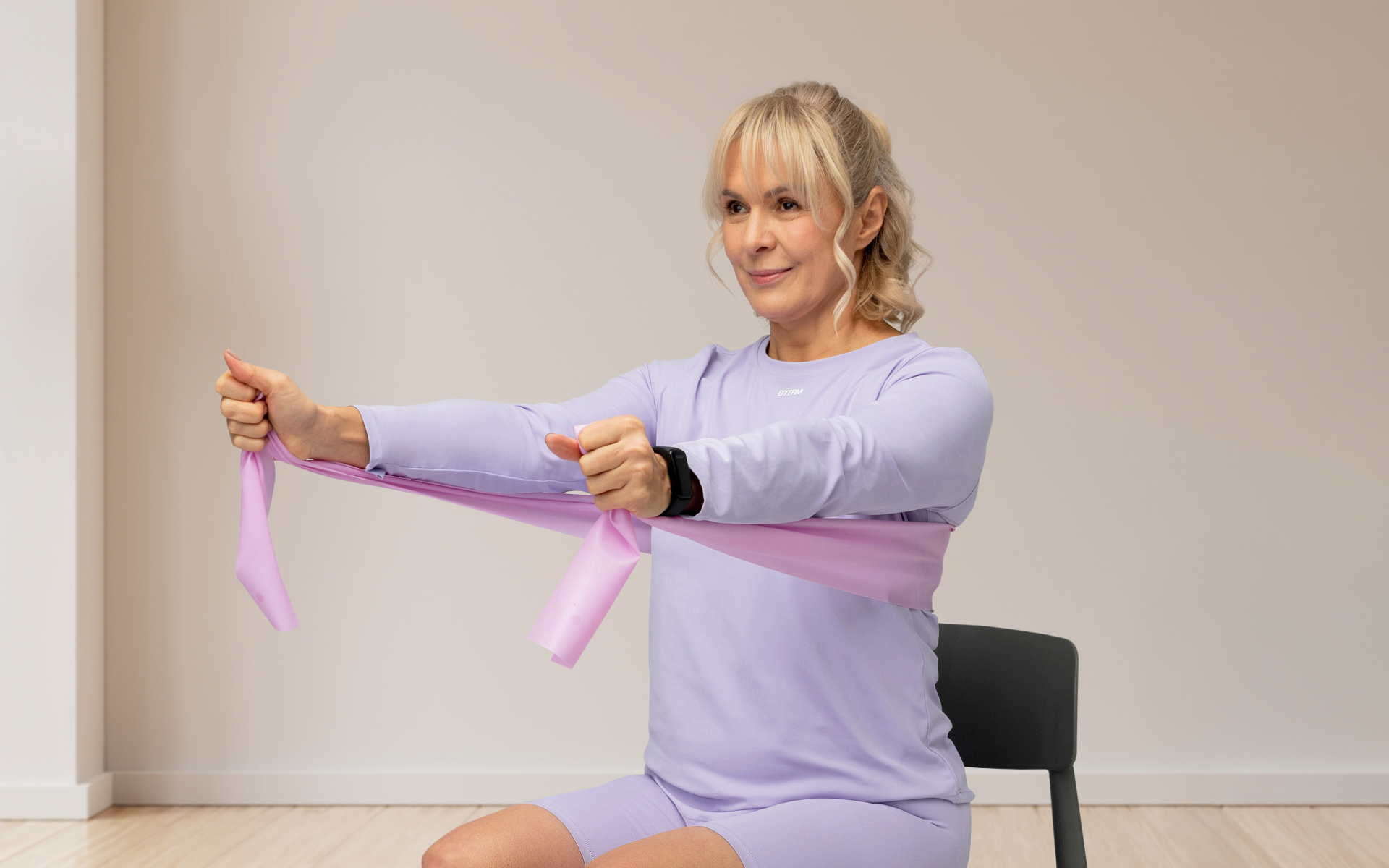Exercises to do in bed sound like a fantasy for those who love binge-watching Netflix or staying in later in the morning. Fortunately, you don’t need to travel to an alternate universe in order to achieve workouts without leaving your bed. Stretching, toning, and losing weight in bed are possible. Who knew you could have and spend a lazy Saturday morning instead of hitting the gym at five? Let’s see how it’s possible.
Get your personalized
meal plan!
How Can I Exercise In My Bedroom?
Here are quick highlights of exercises to do in bed:
- Simple bed exercises strengthen the core as a non-athlete (4)
- Sit-ups in bed improve flexibility and reduce injury risks on supportive surfaces (16)
- Woking on the glutes, core, and hamstrings with glute bridges can be done while in bed (9)
- Nighttime bed workouts can improve sleep (8)
- Bed workouts that cause muscle fatigue may aid weight loss (11)
Let’s see the complete picture of what to expect.
Is It Okay To Do Exercises On Your Bed?
Exercises to do in bed bring exciting thoughts to mind. Let’s use those thoughts to understand how training in bed works. Canadian researchers found that young couples can burn calories while having sex (7).
However, most bed workouts are toning and strengthening exercises. So, let’s look at how a bed is an unstable but supportive surface.
The Canadian Society for Exercise Physiology published its stand and take on the connection between uneven surfaces and conditioning (4):
- Various workouts use soft but firm supports
- Adding instability improves balance and core workouts
- Abdominal bracing is better than abdominal hollowing in stabilizing the spine
- Unstable resistance training is excellent for non-athletic persons who want to tone and strengthen muscle groups
Bed exercises work better for non-athletic training or as part of a more extensive workout plan. Meanwhile, your resistance-style exercises in bed may burn fat to aid weight loss. Swedish researchers found that resistance-style or weighted workouts cause lipolysis (11).
Resistance workouts on a bed that cause fatigue may promote lipolysis when the body breaks down fat to release fatty acids for energy. Consequently, correct exercises in bed may result in weight loss.
Do Sit-Ups In Bed Work?
The Southeastern Spine Institute doesn’t recommend sit-ups with a bad back because of the injury risk (13). Constant bending in the sit-up position places increased pressure on the lumbar spine. The North Central Surgical Center suggests using a stability ball to improve your range of motion and strengthen your core (16). Ultimately, doing sit-ups in bed is safer than on a floor because your bed’s unstable but firm surface provides support.
Read More: Running 1 Mile Calories Burned And How To Maximize Results
Exercises To Do While Lying In Bed
Exercises to do in bed simplify your life when you’re not quite ready to get out of bed.
3 In-Bed Exercises For Everyday Strength
The Canadian Society for Exercise Physiology is clear about how bed workouts strengthen muscles for non-athletes (4).
You can add these workouts to a more vigorous cardio plan or other resistance training if you’re athletic:
Bed Dips
Livestrong says that bench dips are perfect for beginners who aim to work their triceps and upper-body pecs (21). Targeting the arms and upper body with a bed workout can be challenging, so this one creates a fuller body workout with the coming exercises.
How to perform Bed Dips?
- Place your hands behind you on the bed’s edge but far enough to support you.
- Your fingers must face forward as you keep those feet flat.
- Raise your body to straighten your elbows.
- Lower your body slowly until your elbows reach a 90° angle.
- Raise yourself again before doing 20 reps.
Glute Bridges
WebMD suggests using glute bridges to target the glutes, hamstrings, and core for a broader resistance workout (9). You can also add a resistance band to increase the glute workout. It’s a gentle lower-body toner in bed.
How to perform Glute Bridges?
- Lie on your back with your knees bent, shoulder-width apart.
- Keep those feet flat and toes pointed forward with your heels, eight inches from your glutes.
- Squeeze your abs, engage your glutes, and raise your hips.
- Don’t arch your back as your hips rise.
- Create a straight line with your bridge pose.
- Squeeze your glutes and abs tighter as you hold the pose for ten seconds.
- Drop back slowly before doing 20 reps.
Sit-Ups
The Insider suggests that sit-ups are also great workouts for core muscles, not just abs (19). Sit-ups also target the rectus abdominus, a muscle running up the front of your abdomen, and strengthen the hip flexors.
How to perform Sit-Ups?
- Place your hands behind your head as you bend your knees.
- Engage your core muscles as you bring yourself as high as comfortably possible.
- Don’t raise yourself high enough to hurt your lower back.
If you wish to free yourself from all the extra pounds that have been weighting you down for way too long, start using the BetterMe app and overhaul your entire life!
2 Ab Exercises To Do In Bed
The Cleveland Clinic shares common abdominal muscles (2). The rectus abdominus, obliques, and transverses abdominus are major ab muscles that you can work to get better abs.
Reverse Crunches
Insider suggests using crunches to target the abs better (19). Crunches isolate the obliques and rectus abdominus muscles around your abs for a targeted bedside ab workout.
How to perform Reverse Crunches?
- Put your palms down next to your sides as you lie flat on your back.
- Use your abs to raise your straight legs until your toes come close to the headboard.
- Gently lower your legs back to the bed while keeping those abs engaged.
- Avoid arching your back off the bed as they come down.
- Complete ten reps before doing three sets with 30-second resting periods.
Side Planks With Twists
Cleveland Clinic says planks work the rectus abdominus, obliques, and transverses abdominus (12). They target the muscles in front, along the sides, and in the deepest core of your abs to engage those packs.
How to perform Side Planks with Twists?
- Rest your right forearm on the bed as you lie on your side.
- Stack your hips, feet, and shoulders.
- Engage the core muscles as you lift your hip.
- Stretch the free arm toward the ceiling as your hip goes as high as possible.
- Lower your hips to the bed without touching the bed.
- Twist your waist gently to bring your free arm under your body.
- Return to the starting position to count one rep.
- Complete 12 reps on either side.
2 Exercises To Do In Bed For Legs
Exercises to do in bed include leg workouts that target specific muscles. The Cleveland Clinic suggests using exercises that work the hamstrings, adductors, or quads (20). Other leg muscles can also work in bed exercises.
Roundhouse Kicks
Thai researchers studied the roundhouse kick to see how effective it was for Taekwondo practitioners (6). The movement activates the gastrocnemius medialis calf muscle, which flexes the knees and foot. It also activates the rectus femoris between the knees and hips. You cannot expect to do the blackbelt movements immediately, but you can do the bed alternative instead.
How to perform Roundhouse Kicks?
- Extend your arms and legs as you lie on your back.
- Lift your right knee two inches off the bed to rotate it up and round in a wide circular motion.
- Keep the leg straight as you rotate it to reach a level position with your right hip.
- Move it to your body’s center before letting it back down.
- Slowly repeat the movement five times and with controlled movements on the same leg.
- Reverse the direction on the same leg before completing ten reps for each leg.
Supine Leg Marches
Supine leg marches are a variation of the glute bridge. According to WebMD, the glute bridge targets your glutes and hamstrings for an excellent leg workout (9). The core workout is a bonus.
How to perform Supine Leg Marches?
- Bend your knees, keep your feet flat, and rest your arms next to you while lying flat.
- Raise your buttocks until your body forms a straight bridge shape.
- Support yourself with one heel as you raise one leg off the bed.
- The rising leg should bring your knee to align with your hips.
- Lower your leg before repeating on the other side without resting your bridge pose.
- Complete 15 reps to feel the burn.
Read More: Walking 1 Mile Calories: A Detailed Breakdown
2 Exercises To Do In Bed At Night
Johns Hopkins Medicine suggests exercising two hours before sleeping to avoid an endorphin overload that keeps you awake (8). Endorphins will reduce stress and help you relax before bed, but exercising may keep you awake too soon before sleeping. Hence, it’s better to stretch out. These poses are excellent for seniors, too.
Child’s Pose
The North Shore University Health System shares the benefits of doing yoga stretches before bed (3). Yoga relaxes the muscles and releases tension before bed. Doing yoga stretches in bed at night can help you relax and sleep better.
How to perform Child’s Pose?
- Start on your hands and knees before sinking your hips into your heels.
- Stretch your arms forward to widen your hips and relax your belly closer to the bed.
- Hold the position for 60-120 seconds.
Seated Forward Fold
Yoga doesn’t only relax you before bed, as it also improves blood circulation to help you ease into sleep faster or wake up easily in the morning (3). Try the seated forward pose to relax more.
How to perform Seated Forward Folds?
- Place your legs straight in front of you before bending your hips over gently.
- Relax your arms down your sides as you separate your legs slightly to make space for your belly.
- Use a pillow between your belly and legs if you feel uncomfortable.
- Hold the pose for 60-120 seconds.
3 Exercises To Do In Bed For Seniors
Exercises to do in bed for seniors open a world of comfort on your bed when you want to stretch out those muscles in the morning. Meanwhile, they should offer additional safety benefits or improve the range of motion.
Incline Push-Ups
Livestrong recommends incline push-ups for seniors with a lower range of motion (17). Also, when your body starts to incline, you place less pressure and weight on your decline.
How to perform Incline Push-Ups?
- Rest your hands against the bed’s edge as you step back slowly.
- Stop when your hands are slightly wider than your shoulders.
- Your body will form a plank position before you engage the core muscles.
- Bend those elbows as you drop until they reach a 90° angle.
- Keep your spine straight as you descend and return for 20 reps.
Yanking yourself back in shape has never been so easy with our game-changing fitness app! Start transforming your life with BetterMe!
Knees-To-Chest
Livestrong suggests using knees-to-chest exercises to loosen tight muscles early in the morning (10). Moreover, relaxing those tense muscles may reduce back pain. It’s also a minimal-risk exercise for seniors.
How to perform Knees-To-Chest?
- Sit on the bed’s edge as you engage your core and bring those knees to your chest.
- Squeeze your legs together without expecting your knees to come too high.
- Slowly lean backward as your legs begin stretching outward.
- Your body will form the shape of a “V”.
- Hold the position as long as you can before returning the way you came.
- Do 12 reps to complete a morning workout.
Straight Leg Lifts
The Cleveland Clinic participated in research examining the straight left raise test (14). The test helps physiotherapists determine lumbar conditions and pain. However, they also use the same movements as a senior exercise with spine or knee problems.
How to perform Straight Leg Lifts?
- Flex your feet with toes to the ceiling and straight legs while lying flat on your back.
- Lift one leg until it reaches 45°, or stop before you feel discomfort.
- Engage your front thighs to help the quad muscles.
- Hold your leg up for a second before lowering it.
- Complete 15 reps on each leg before doing three sets with 30-second intervals.
2 Exercises To Do In Bed To Lose Weight
The Swedish researchers struck gold when they realized how muscle fatigue causes fat-burning effects (11). Bed workouts with enough reps and sets may help you lose weight.
Dolphin Plank
Livestrong explains how the dolphin plank is a bodyweight exercise (15). Bodyweight workouts can increase resistance naturally without adding weights.
How to perform Dolphin Plank?
- Put your forearms and palms on the bed as you get into a plank position.
- Your shoulders stack over your elbows with your back straight.
- Tighten your core as you raise your hips and lower your head into a dolphin pose.
- Hold the dolphin for a second before releasing it in a controlled manner.
- Complete 30 reps to cause muscle fatigue.
Unilateral Dead Bugs
The Yorkville Sports Medicine Clinic recommends dead bugs as a bodyweight exercise (18). Bodyweight exercises let you use your natural weight to increase resistance.
How to perform Unilateral Dead Bugs?
- Fully extend your arms over your head as you lie on your back.
- Raise your legs until they reach a 90° angle with the bed.
- Extend one leg toward the bed and the other leg closer to your head.
- Keep both legs straight, however, remember to stop if it starts to hurt.
- Return your legs to the 90° angle before repeating it for 30 reps.
- Switch sides to do another 30 reps using the opposite legs.
2 Bed Exercises For Belly Fat
The Swedish researchers proved that muscle fatigue through resistance-style or weighted workouts might burn fat (11). You may use exercises that target the stomach muscles to help tone your belly as you burn fat.
Jackknife Sit-Ups
Insider explains how sit-ups target more muscles than your abs alone, but you can use a variation to burn those abs instead (19). Jackknife sit-ups work the abdominal muscles harder, allowing faster muscle fatigue.
How to perform Jackknife Sit-Ups?
- Stretch your arms overhead and raise your legs out straight to form a V-shape.
- Contract your core muscles hard while bringing your arms and legs closer to each other.
- Your legs and arms should form a 45°angle but don’t push until it hurts.
- You’ll gently lift your head off the floor with your arms and legs moving closer together.
- Don’t tuck your chin or allow your forehead to fall backward.
- Gently lower your head, arms, and legs before completing 30 reps.
Oblique Twists
Cleveland Clinic explains that oblique twists target the two major muscles on the sides of your abdomen, even helping you burn fat (1). Doing oblique twists on a bed may burn belly fat.
How to perform Obliques Twists?
- Sit straight with your legs flat against the bed.
- Raise your arms to a 90° angle in front of you.
- Your elbows line up with your shoulders as you engage your core.
- Keep your head aligned with your upper torso as you move side to side for 120 seconds.
- Return to the start and rest your arms before repeating the exercise 30 times.
FAQs
How To Exercise In Bed?
Harvard recommends speaking to your doctor before starting any new exercise routine (5). Bed exercises fall under unstable surfaces as a new program type. The Canadian Society for Exercise Physiotherapy recommends unstable surface exercises because they benefit and support you (4). However, speak to a physician first, especially if you have a history or current injuries or pain.
Is It Okay To Do Sit-Ups On A Bed?
Yes, you can do sit-ups in bed. Beds provide unstable surfaces to help non-athletes still achieve conditioning (4). The North Central Surgical Center says stability balls are similar in supporting and improving a workout. Sit-ups in bed are safer and place less pressure on the spine because the bed is unstable workout equipment.
What Exercises Can I Do In Bed To Lose Weight?
Swedish researchers found that you must cause muscle fatigue or overload to increase your metabolism and lose weight (11). Dead Bugs are a resistance-style workout to burn fat and lose weight (18). Also, dolphin planks increase body weight resistance to help with weight loss (15).
What Exercises Can I Do In Bed To Lose Belly Fat?
Swedish researchers confirmed how causing muscle fatigue may lead to lipolysis (11). Lipolysis is when the body breaks fat down to create energy. So, use 30 reps of jackknife sit-ups and oblique twists each on a bed to cause muscle fatigue in the right region to burn belly fat.
What Are The Best Exercises To Do In Bed?
The best exercises in bed are resistance-style dead bugs and dolphin planks that can cause muscle fatigue if you desire weight loss (11). Alternatively, use incline push-ups if you suffer from injuries or fall into the senior group (17).
Summary
Exercises to do in bed are as simple as picking your goal. Do you want to lose weight? Do you want to go easy on senior joints? Or would you prefer targeting specific muscle groups while enjoying the latest series on Netflix? Choose your goal, and you’ll have your workout.
DISCLAIMER:
This article is intended for general informational purposes only and does not serve to address individual circumstances. It is not a substitute for professional advice or help and should not be relied on for making any kind of decision-making. Any action taken as a direct or indirect result of the information in this article is entirely at your own risk and is your sole responsibility.
BetterMe, its content staff, and its medical advisors accept no responsibility for inaccuracies, errors, misstatements, inconsistencies, or omissions and specifically disclaim any liability, loss or risk, personal, professional or otherwise, which may be incurred as a consequence, directly or indirectly, of the use and/or application of any content.
You should always seek the advice of your physician or other qualified health provider with any questions you may have regarding a medical condition or your specific situation. Never disregard professional medical advice or delay seeking it because of BetterMe content. If you suspect or think you may have a medical emergency, call your doctor.
SOURCES:
- 6 Desk Exercises That Help You Get Stronger While Working – Cleveland Clinic (2023, clevelandclinic.org)
- Abdominal Muscles: Anatomy and Function – Cleveland Clinic (n.d., clevelandclinic.org)
- Benefits of Yoga Before Bed | North Shore (2018, northshore.org)
- Canadian Society for Exercise Physiology Position Stand: The Use of Instability to Train the Core in Athletic and Non-Athletic Conditioning (2010, researchgate.net)
- Do You Need to See a Doctor Before Starting Your Exercise Program? (2012, health.harvard.edu)
- Effectiveness of Roundhouse Kick in Elite Taekwondo Athletes (2014, pubmed.ncbi.nlm.nih.gov)
- Energy Expenditure During Sexual Activity in Young, Healthy Couples (2013, journals.plos.org)
- Exercising for Better Sleep | Johns Hopkins Medicine (n.d., hopkinsmedicine.org)
- Glute Bridge (2022, webmd.com)
- Knees-To-Chest Stretch: How To, Benefits | Livestrong (2023, livestrong.com)
- Mechanical Overload-Induced Muscle-Derived Extracellular Vesicles Promote Adipose Lipolysis (2021, faseb.onlinelibrary.wiley.com)
- Plank Exercises: What Do They Do for Your Body – Cleveland Clinic (2021, clevelandclinic.org)
- Should You Do Sit-Ups With A Bad Back? The Southeastern Spine Institute (n.d., southeasternspine.com)
- Straight Leg Raise Test | StatPearls | NCBI Bookshelf (2023, ncbi.nlm.nih.gov)
- Strengthen Your Entire Core With This Quick, 4-Move Body-Weight Workout (2022, livestrong.com)
- The Benefits of Exercising With a Stability Ball | North Central Surgical Center (2016, northcentralsurgical.com)
- The Benefits of Incline Push-Ups | Livestrong (2022, livestrong.com)
- The Dead Bug Exercise and How You Can Do It Perfectly (2022, yorkvillesportsmed.com)
- The Major Differences Between Sit-Ups and Crunches – and Which One is Best for You? (2022, insider.com)
- Thigh Muscles: Anatomy, Function, and Common Conditions – Cleveland Clinic (n.d., clevelandclinic.org)
- What Muscles Do Dips Work Out? | Livestrong (2019, livestrong.com)
